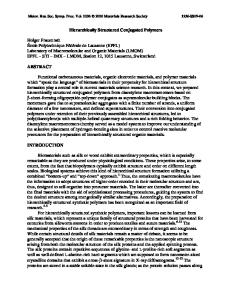Imaging Of Hierarchically Structured Materials
- PDF / 5,628,691 Bytes
- 15 Pages / 420.48 x 639 pts Page_size
- 20 Downloads / 391 Views
IMAGING OF HIERARCHICALLY STRUCTURED MATERIALS MEHMET SARIKAYA and ILHAN A. AKSAY Department of Materials Science and Engineering, and Advanced Materials Technology Center, The Washington Technology Center, University of Washington, Seattle, WA 98195
ABSTRACT We describe techniques used to characterize hierarchicallystructured synthetic and biological
materials. These techniques decipher the structures through the dimensional spectrum from the molecular and atomic scales (10.10 m) to the macro scales (10-3 m) where the overall shape of the material emerges. Techniques used to image surfaces and internal structures can be categorized according to their wavelength and thus spatial resolution as light, x-ray, and electron microscopy. We also discuss newly emerging microscopy techniques that image surfaces at the atomic level without a focusing lens, such as scanning tunneling and atomic force microscopies, with the aid of field ion microscope and scanned probe microscopes. Transmission electron microscopy (TEM), a unique tool for multipurpose imaging, provides structural information through direct imaging, diffraction, and spectroscopic analysis. We illustrate the major TEM techniques used to analyze structuralhierarchy with examples of synthetic and biological materials. We also describe light optical microscopy and scanning probe microscopy techniques, which cover the opposite ranges of the dimensional spectrum at the micrometer and subangstrom levels.
1. INTRODUCTION AND BACKGROUND ON HIERARCHICAL STRUCTURES Hierarchically structured materials display distinct architectural designs at successively varying length scales, with each level of structure a self-forming entity.t In this definition, each level of structure is locally diverse, yet interactive through successive levels, thereby generating a larger overreaching structure with unique properties that reflect the contribution of phenomena taking place at various levels of the hierarchy. Although the internal structures in each level of the hierarchy provide the intrinsic properties of material, it is the interfaces between the hierarchical levels that allow interaction between levels and provide continuity at each step throughout the entire structure. In synthetic materials,1 ,2 such as crystalline ceramics or metals, the hierarchy may include the levels summarized in Figures 1 and 2, with the smallest level a few angstroms containing a single atom. The next scale in the hierarchy would be the unit cell which represents the smallest crystallographic entity. In a single crystalline material, the unit cell would repeat itself through the entire material in three dimensions with no higher level of hierarchy. In the single crystalline state, thermodynamically dictated imperfections such as vacancies, interstitials, and dislocations constitute the first level of structural features in the hierarchical ladder. 3 Most materials of technological importance, though, are not single crystalline, but instead are aggregates of finite size single crystalline grains (Figure
Data Loading...










